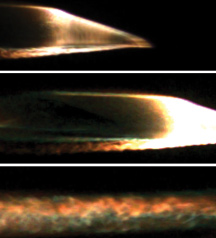Stay Up to Date
Submit your email address to receive the latest industry and Aerospace America news.
The Weapon System Effectiveness Technical Committee advances the science and technology of predicting, measuring, evaluating and improving the lethality of weapon systems.
Multiple U.S. government-led boost-glide and air-breathing prototype-development efforts continue to progress in the realm of hypersonics, defined as flight above Mach 5. The Conventional Prompt Strike program is moving the prototype Common-Hypersonic Glide Body, or C-HGB, from Sandia National Laboratories to commercial production. Specifically, in August, Dynetics Technical Solutions, based in Alabama, with subcontractors General Atomics Electromagnetic Systems, Lockheed Martin and Raytheon, was awarded a $351.6 million program to produce 20 C-HGB prototypes for the U.S. Army, Navy and Missile Defense Agency.
These glide bodies are intended mainly for testing, but the Army’s goal is to deliver a residual combat capability to soldiers by 2023. This effort is part of Long Range Precision Fires, one of the Army’s priorities handled under cross-functional teams. The six cross-functional teams fall under the new U.S. Futures Command, which was stood up in Austin, Texas, last year.
Also in August, Lockheed was selected for a $347 million contract to integrate at least eight of these glide bodies into a battery of Long Range Hypersonic Weapon launchers. Subcontractors to Lockheed Martin are Dynetics, Integration Innovation Inc. (i3), Verity Integrated Systems, Martinez & Turek, and Penta Research. The Air Force also has two ongoing hypersonics boost-glide weapons programs: Advanced Rapid Response Weapon and Hypersonic Conventional Strike Weapon. DARPA and the Air Force are also funding the Tactical Boost Glide and Hypersonic Air Breathing Weapon Concept programs. In support of these major programmatic efforts, progress continued on multiple other research, engineering and policy initiatives. These include programs looking to expand the national testing infrastructure, grow the hypersonics engineering talent pipeline, and increase the development and manufacturing capacity of advanced materials that can handle extreme conditions.

On the defensive side, there are ongoing programs related to defeating these maneuverable bodies. Last year MDA put out a solicitation and funded 21 $1 million studies for defense. In August and September, five of these were selected for more work, all with roughly $4.5 million in additional funding, namely to Boeing for Hypervelocity Interceptor Concept for Hypersonic Weapons, Lockheed Martin for Valkyrie Interceptor Terminal Hypersonic Defense, Lockheed Martin for Hypersonic Weapons System Defense Concept-Dart, Raytheon for Non-Kinetic Concept for Hypersonic Defense and Raytheon for SM-3 Hawk.
Along with these awards, there is much discussion about a space-based sensor layer for missile defense. The ability to observe and track a hypersonic vehicle in flight is essential due to the missiles’ maneuverability within the atmosphere.
Missile defense is progressing in other areas. March saw the first salvo test of the Ground-based Midcourse Defense segment: two ground-based interceptors, or GBI, were launched from Vandenberg Air Force Base in California in response to the launch of the complex intercontinental ballistic missile target from the test site on Kwajalein Atoll. The lead GBI of the two-missile salvo intercepted and destroyed the target reentry vehicle. The second, trailing GBI examined the resulting debris and remaining objects. Not finding any other reentry vehicles, the trailing GBI selected the next most lethal object and struck it. There were also continued flight intercept tests by both the THAAD and Arrow systems.
Related Posts
Stay Up to Date
Submit your email address to receive the latest industry and Aerospace America news.




